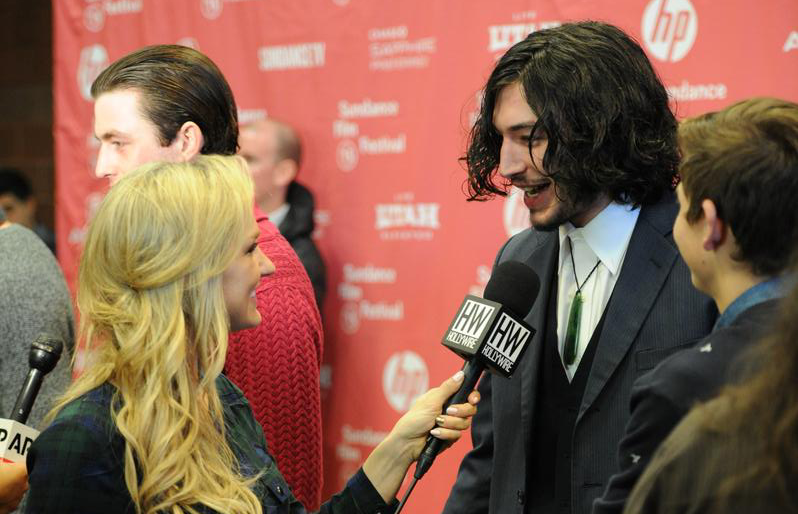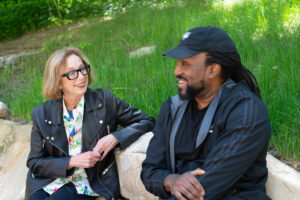Ezra Miller (left) at the premiere of “The Stanford Prison Experiment.” ©Sundance Institute | Stephen Speckman
Sundance Institute
Sudance.org is dispatching its writers to daily screenings and events to capture the 10 days of festivities during the Sundance Film Festival in Park City, Utah. Check back each morning for roundups from the previous day’s events.
The Stanford Prison Experiment
by Nate von Zumwalt
Kyle Patrick Alvarez may not be the second coming of Dr. Philip Zimbardo, the groundbreaking psychologist at the helm of the Stanford Prison Experiment, but that doesn’t preclude his new film from playing like a microcosm of those chilling events. One could speculate that every film screening is an “experiment” of sorts, as a number of audience members intimated during The Stanford Prison Experiment’s Q&A session, but Alvarez is loath to concede that his film manipulates with the same scheming tendencies as the experiment itself.
About that experiment (which Alvarez worked pedantically to adhere to in the film, even going so far as to enlist Zimbardo as a consultant). In the summer of 1971, Zimbardo (played by Billy Crudup in the film) conceived a project that would simulate the conditions of a prison by soliciting 24 exceedingly “normal” men to play the roles of guards and prisoners. Assigned at random, the participants inhabit their roles on a 24/7 basis and under the analytical surveillance of Zimbardo and his team. With only a basic—and albeit ambiguous—condition that the guards may not physically assault the prisoners, the experiment develops with an escalating dubiousness as a number of guards adopt a nearly fascistic attitude that is perpetuated by unruly behavior from the prisoners—most notably an increasingly unstable Ezra Miller. Just as the guards begin to revel in their newly instituted authority, the prisoners find that the ostensible “experiment” is more closely aligned with reality than simulation. Not even two days into the project, Miller’s character begins to break down after a protracted stint in ‘the hole,’ a room for solitary confinement from which he implores for a release while proclaiming that the experiment is not allowed to “fuck with my head.” As the project takes on a life of its own, Zimbardo and his team are forced to reconcile the potential benefits of their research with the traumatic repercussions for its subjects.
Experiment.” ©Sundance Institute | Stephen Speckman
It would be facile to call The Stanford Prison Experiment a ‘challenging’ film—that designation should be reserved for the emotionally gripping experiment itself. But there is a tinge of a test (despite the director’s belief otherwise) in Alvarez’s dedication to veracity, which does not play as a fault in this case. “We really were careful to make sure the movie didn’t hit too hard too fast so that hopefully it wouldn’t become a test. I wanted to make sure that it always felt accessible as opposed to the movie being a constant endurance test for the audience.”
Perhaps more notable than the film’s stellar direction—and Alvarez’s deftness in working with the confines of the true story—is the way the film is entirely hands-off in dealing with the moral ambiguity of the experiment. That fueled Alvarez’s inclination to remind the audience that, ultimately and arguably, nothing truly horrific happened. “One of the things that I found really fascinating about the experiment was that they walked away—they ended it,” said Alvarez. “It was ultimately more an expression of humanity than it was of how bad humanity is.”
Zimbardo himself, who was in attendance for the screening but did not take the stage during the Q&A, spoke with a similar sentiment. “What’s not in the film is that when the study was ended, we spent a full day in psychological debriefing,” he said. “We spent hours with all the prisoners, hours with all the guards, and then we brought the prisoners and guards together. And we literally called it ‘moral reeducation.’ I was able to say, all of us did bad things, including me. Aside from the guards that did bad things, the good guards never once interfered to prevent the bad guards from doing what they did. The prisoners who didn’t break down, never gave support to the fellow prisoners that did break down.”
For Alvarez, he hopes that audiences can glean the significance of the story. “I think what’s important is to acknowledge that it’s still incredibly relevant today in terms of how we’re given authority and what that authority means. And i think it’s really important to note that a lot of people involved in this experiment, Dr. Zimbardo and many of the grad students, went on to participate in prison reform.”
Results
by Jeremy Kinser
Andrew Bujalski returns to Sundance with Results, a perceptive comedy set in the world of fitness trainers that examines the relationship between money and happiness.The movie premiered at the Eccles in the U.S. Dramatic Competition, and it’s not only his most accessible project to date, it also marks his first foray into directing professional actors.
Newly-rich, recently-divorced, perpetually schlubby Danny (Kevin Corrigan) decides to change his life by visiting a local gym, but unwittingly and inextricably becomes entangled in the low-simmering romance between fitness guru Trevor (Guy Pearce) and trainer Kat (Cobie Smulders). During the Q&A that followed the screening, Bujalski, who will likely forever be known as the “Godfather of Mumblecore,” seemed as surprised as anyone to have made such a mainstream romantic comedy.
Brooklyn Decker. ©Sundance Institute | Stephen
Speckman
He said while attending the festival two years ago he was pressured to come up with a new project to pitch. After directing four movies with non-professional actors, he decided to break out of his comfort zone and work with pros. “I started thinking very specifically about Guy Pearce and Kevin Corrigan, who I’ve been a fan of for years,” he shared. “I don’t know why, but it just made me laugh. I thought it would be fun to see those two mix it up in a movie together.” Bujalski also draws winning comic performances from his supporting cast that includes Brooklyn Decker, Anthony Michael Hall and Giovanni Ribisi.
The director said shooting in a gym inspired all kinds of “fitness shenanigans” and added that the cast was constantly doing pushups. Bujalski didn’t pressure his cast to get fit during the shoot, which was probably unnecessary since Pearce had been a teenage body builder. “He loved having the excuse to go hit the gym,” Bujalski suggested. “If Guy was here he’d tell you how out of shape he is, which is not true.”
However, the director also caused gasps from the audience by revealing Smulders, who sports a lean, taut physique in the film, had been four months pregnant when making the comedy. This news initially caused Bujalski to panic, but he assured the audience there had been no actual problems during the shoot.
Pervert Park
by Eric Hynes
People, places, and stories aren’t always what you expect them to be in Pervert Park, a moving and bravely humane documentary about a self-contained community of sex offenders in St. Petersburg, Florida. As Swedish director Frida Barkfors and her Danish husband Lasse Barkfors said during the post-screening discussion for their debut film, they were also surprised by what they found in the park.
“We read an article in a Danish magazine about 5 years ago. And the park was described as a parallel society, where they didn’t really leave the park and created jobs for themselves because they couldn’t be part of society,” said Frida Barkfors. “So we went there to film that, and it turned out to not be the case exactly,” since residents regularly work, attend school, shop, and visit friends outside the park. They also found both men and women of many ages who had been convicted and served time for of a wide array of crimes—in person and online, onetime and repeat offenders, intra- and extra-familial offenses—and all the residents were deep into recovery and rehabilitation when the directors met them. “We hadn’t given much thought about what a sex offender was, because we bought into the stereotype picture that mainstream media is telling. So when we came there we were quite surprised by the whole situation, and tried to portray just what we found.”

The subjects of the film give extensive onscreen testimonies about their lives, describing both their crimes and their own troubled childhoods, which often involved brutal, cycle-generating abuse. “I cried a lot during the interviews,” Frida said. “There were different emotions connected to each different person. I was appalled and angry,” with some of the interviewees, “but I also cared for them.”
That sense of caring was crucial from the start, and helped earn the trust of the residents. “The first time we got there we spent a week with them, just sitting in therapy classes and following them around and talking. Just to get them used to us being there,” Lasse Barkfors said. “Then during three years we tried to finance [the film], based on a teaser, we stayed in contact with them and remained dedicated to telling their stories.”
“A key to gaining their trust was approaching them with no hidden agenda or labeling, because they’re so used to being labeled. So once we entered the park with this approach of just wanting to listen to them, they opened up to us,” Frida said.
During the post-screening discussion, members of the audience wondered why the film doesn’t feature interviews with members of law enforcement, or the victims of the crimes. In addition to the strong formal decision to never leave the park during the film—everything and everyone we see takes place in its environs—the directors were determined to limit the scope of the film to this one aspect of a complex and tragic phenomenon. “We never saw this film as a journalistic film. So we decided early on that we weren’t going to include all the different perspectives. We just wanted to give a voice to the people who are normally not heard,” Frida Barkfors said.
Cronies
by Jeremy Kinser
The stark, black-and-white St. Louis-based drama drama Cronies marks not only writer-director-producer Michael J. Larnell’s debut at Sundance (it screened in the NEXT section), it’s also his thesis film at NYU. The film offers an interesting study of male camaraderie and follows a trio of friends in St. Louis during a typical day in the life that ranges from fishing, smoking, ogling girls, and a stolen car.
The film has already received a boost in awareness due to Spike Lee’s credit as executive producer. Larnell said he applied and won a grant offered by Lee, who teaches third year students at NYU. “I showed him the first 10 minutes and he decided to become the executive producer on the film,” he added. Larnell shot the film in 12 days in St. Louis, his hometown.

Larnell said he always intended to shoot it in black-and-white, partly as a nod to Lee’s She’s Gotta Have It and because of his admiration for the french film La Haine, another drama about three friends over the course of a day. The first-time director draws naturalistic performances from his three non-professional actors, George Sample III, Zurich Buckner, and Brian Kowalski, who responded to a casting call advertised on the local news.
The film’s casting director Albert A. Smith said he and Larnell were looking more for interesting characters, rather than accomplished actors. “A lot of people came in and we felt out the people with the right vibe to make sure they were responsible enough to learn the lines,” he told the audience. Larnell added it was a conscious decision to employ local non-actors. “Someone who wasn’t from St. Louis wouldn’t have the dialect,” he added.
Smith also served as the film’s music director and made vivid use of local musicians, who also responded to an open call. He thinks the film might serve to change public opinion of St. Louis, due to the violence in nearby Ferguson. “I think it’s a blessing that the timing of this film comes where you can see another side of St. Louis and black people,” he suggested to the audience.
“This movie is our reality and perception is left up to people watching it. Some people will see cursing and negativity. Some will see love and hope.”
Beaver Trilogy Part IV
by Eric Hynes
For those of a certain cinephilic bent—the kind that used to pass around bootleg VHS tapes of rarities and oddities, the kind for whom calling a film “cult” is the greatest of compliments—Trent Harris’s Beaver Trilogy is among the greatest of films, an obsessive, formally mutating triptych (documentary to mockumentary to short narrative) about a misfit who just wants to be a star. But for the people of Beaver, Utah, the underground sensation called the Beaver Kid was simply Dick Griffiths, a young man whose chance meeting with Harris in the parking lot of Salt Lake City’s KUTV 2 served as both a big break and a nearly fatal circumstance.
After never receiving any kind of release, in any kind of form, since Harris first met Griffiths in 1979, The Beaver Trilogy was finally screened at the 2009 Sundance Film Festival. Harris’s surprise reunion with his subject at the Eccles premiere, after 30 years without contact, provides director Brad Besser with a hook for Beaver Trilogy Part IV—a loving and cheeky documentary that provides the backstory to the cult film and catches us up to what both men were doing during those years. (Griffiths died just a few months after the Sundance screening.)
“After I’d caught up with him years later Dick said, ‘You know I have been in television over the years.’ And I said really? He said ‘yeah, I repair televisions’,” Harris said during the post-screening Q&A.

“He was a television repairman,” confirmed Dick’s sisters Vicki Hutchings and Laurie Griffiths. “He actually was just an everyday, down-to-earth, give you the shirt off his back guy. He had a million friends. And we loved him. As I said when he passed away, we loved this kid to death. When he died the entire town mourned with us.” As they do in the film, the sisters intimated that participating in Harris’s short documentary prompted a suicide attempt, from which none of them—Griffiths, his sister, perhaps even Harris—seemed to ever fully recover, though this film seems to have brought everyone together. “He always loved Trent Harris. Us sisters—not so much,” they said, before receiving an embrace from Harris.
While he may have been beloved in Beaver, to this day many in the town still don’t know about The Beaver Trilogy, or about Griffiths’ talent for impersonating John Wayne or Olivia Newton John. And while the Beaver Kid may have been at peace living a life beyond the limelight, his time in Park City certainly stoked something inside. As the film shows, he even sent a demo to Harris for a possible fourth installment in the Beaver series. “He had the time of his life at Sundance,” recalled the sisters. “But one day we were talking and he goes, ‘You know what, there’s a lot of people around here that don’t know a damn thing about me. They don’t know that I’m a star and that I’ve been in a movie.’ But people probably know more now than they knew then,” and thanks to Besser’s film, the legend should only grow.




